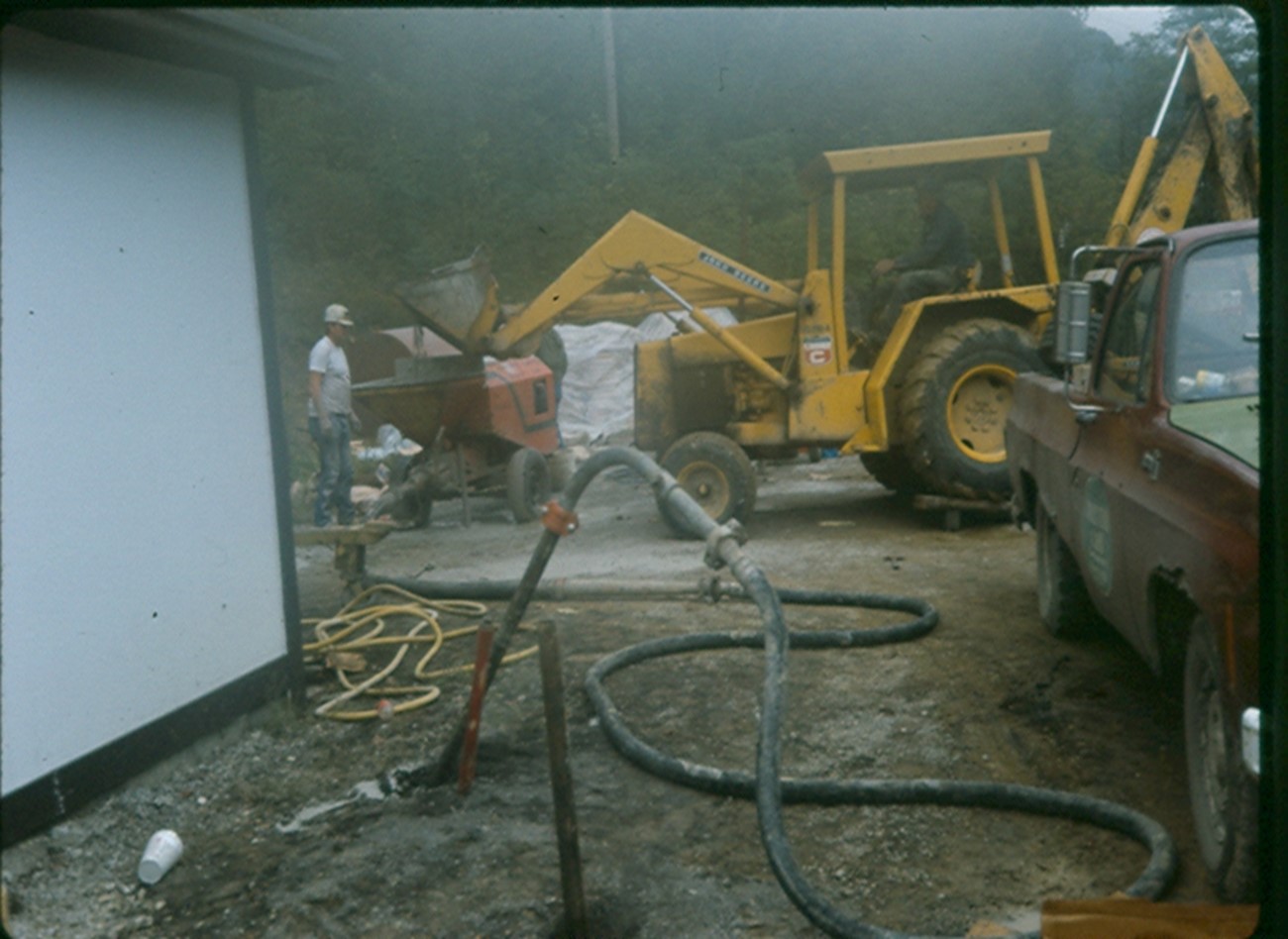Coal Mine Fires and Burning Refuse
Caveat: Coal mine fires or underground mine fires are generic terms for coal seam fires. The reason the “mine” is used within the description is due to the starting point of the fire. The majority of coal seam fires start within active or abandoned coal mines. It is important to note that the mine itself is not on fire, but the remaining coal pillars, remaining coal seam, poor quality coal, or burnable debris left behind is what burns.
Mine Fires: Majority of mine fires start through careless human activity, such as burning debris within an abandoned surface mine; however, mine fires can also start naturally via forest fires, lightning strikes, lava flows or other natural heat sources.
Underground coal mine fires occur around the world, sending thousands of tons of soot, toxic vapors, and greenhouse gases into the atmosphere, leading to pollution of surface and groundwater, mine subsidence as the coal is consumed, and ignition of forest and structural fires. Areas like the resort town of Glenwood Springs, Colorado has been plagued by series of suspected mine fire caused forest fires which burned thousands of acres of forest and many local residences.
Underground Mine Fire Thermal Cycle

When the fire travels into the ground from the surface it creates a thermal cycle. The thermal cycle consists of the fire heating the air causing it to rise and escape through passageways (fractures) in the ground. The points on the ground surface where the heated air discharges into the atmosphere are known as vents. The heated air carries the greenhouse gases, noxious fumes, soot, and smoke. These vents are extremely dangerous and pose a serious health risk. Vents encountered or discovered need to be avoided, never get closer than 100 feet to a vent.
With the hot gases rapidly venting, this creates a negative pressure at the fire face. Cooler, oxygenated air drawn from the outside atmosphere is pulled into the ground and ultimately to the fire, thus completing the thermal cycle. As the fire spreads into the coal seam new vents can form and old vents can change becoming intake vents.

According to e-AMLIS, in 2013 there were 98 underground mine fires in 9 states. This is considered to be an underestimate for the actual number of fires nationwide.
Coal mining states programs address mine fire and coal refuse fire related emergencies. These fire emergencies can threaten to ignite forest fires and underground mines fires that can burn beneath buildings, roadways and grounds releasing deadly gases and causing mine subsidence. Abatement methods range from complete excavation and quenching with water, to the use of specialty foaming cements and firefighting foams that are injected into the fire through boreholes drilled from the ground surface. Other techniques that may be used include the use of liquid nitrogen to extinguish the fire by the rapid removal of heat.
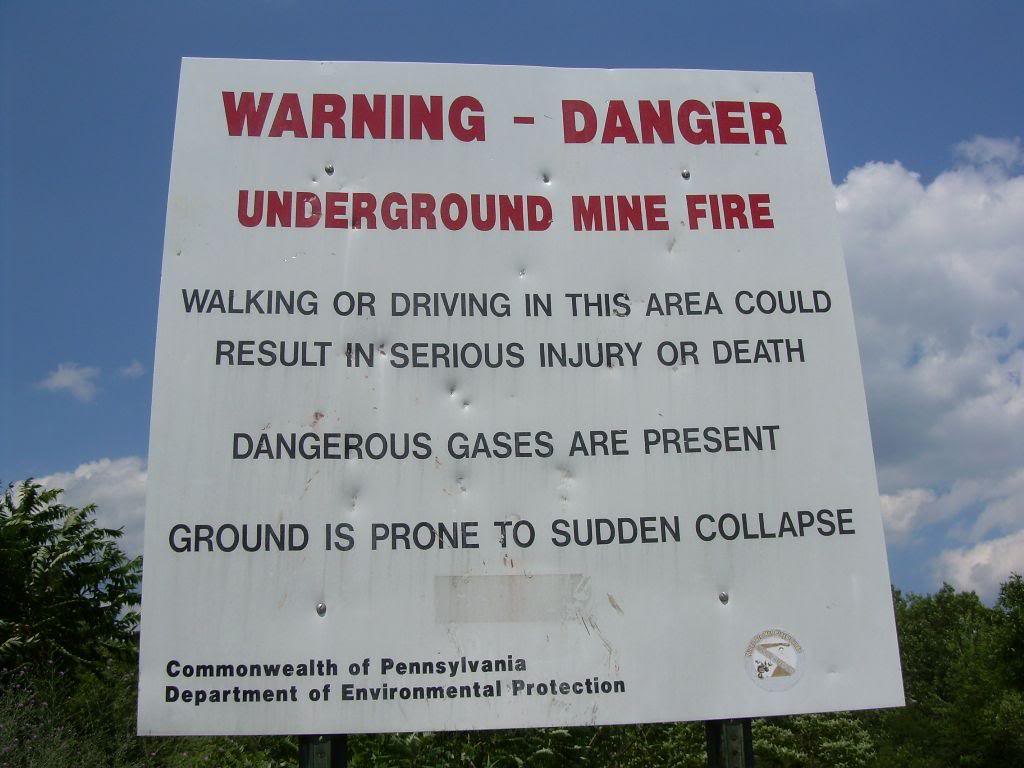
For information regarding this webpage and Mine Fires please contact:

Frequently Asked Questions
Types of mine fires:
- Burning coal seam: This type of underground fire follows the fuel source (carbon) along the coal seam. Based on geological structure, these fires break into two categories:
- Horizontal coal beds
- Coal seams which are generally flat lying. Occurrences are generally east of the Rockies and in Northern Alaska. Fires within these coal beds are typically easier to characterize and delineate.
- Angular beds
- These coal seams follow geologic structures such as anticlines and synclines. The angle degree can be up to 90 degrees. These type of coal seams occur within the Rocky Mountain and Southern Alaskan Ranges as well as the anthracite fields of Eastern Pennsylvania. Due to the angled bedrock, characterization and delineation of these fires can be difficult.
- Horizontal coal beds
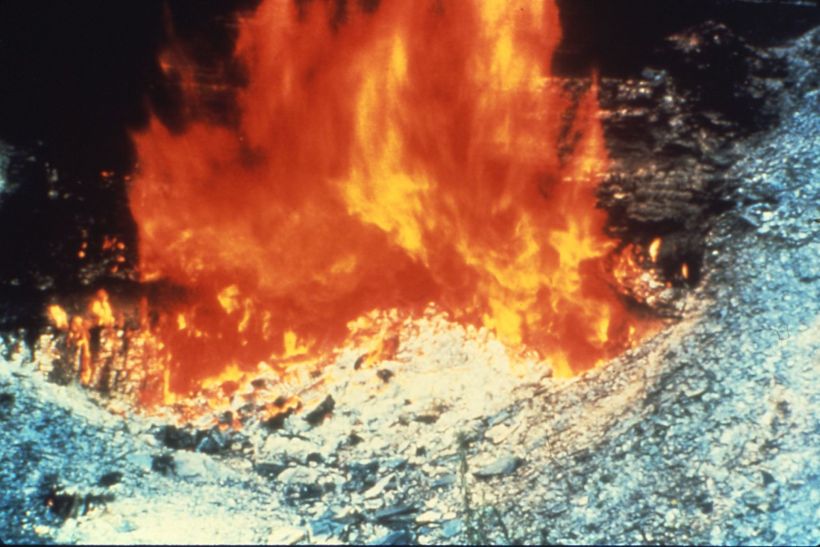
This example is a burning coal seam where it outcrops. With the fire at the coal seam outcrop, there is plenty of oxygen in the air to cause the fire to burn rapidly with large flames. As the fire advances underground, the available oxygen will diminish limiting flame height and the fire takes on a smoldering appearance.
- Burning Refuse: These fires occur within coal waste piles or culm piles. Not confined to a singular seam, this fire type will burn from the ignition point spreading out into the pile. The difficulty in extinguishing these fires is due to the size of these piles. These piles can range in size from an acre to hundreds of acres, with the largest being 1.5 miles in length.
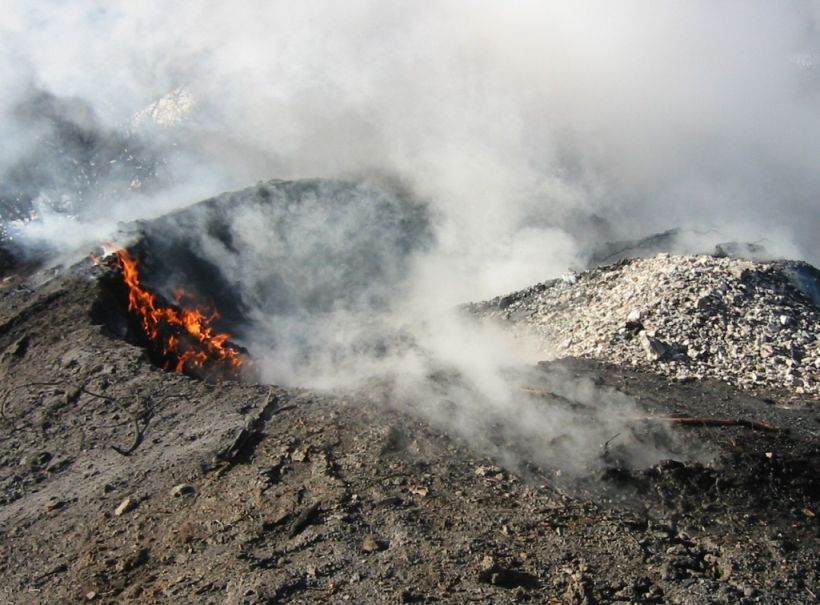
This is an example of a coal waste pile burning. Note how small the flames are. This is due to the material itself inhibiting the amount of available oxygen for the flame.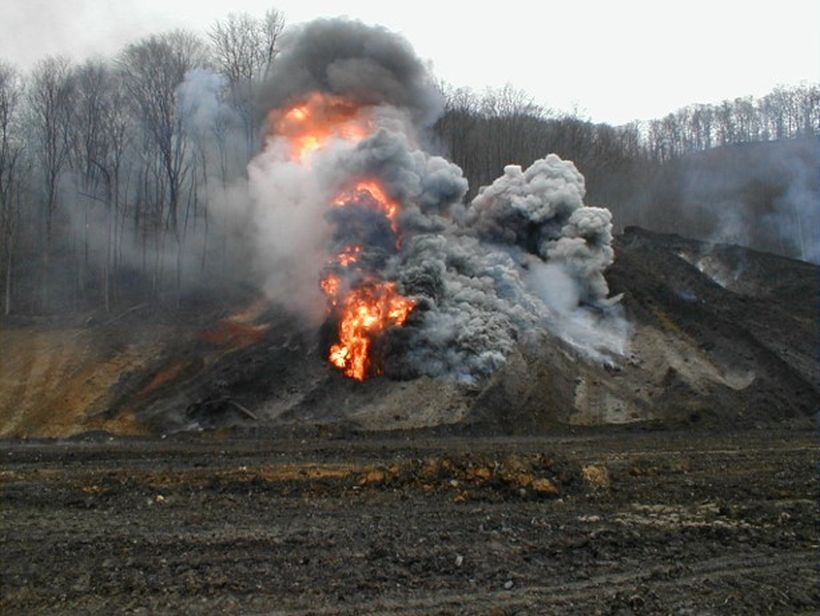
This image is an example of a burning refuse pile which has been mixed allowing more fuel (carbon) to reach the higher concentration of oxygen in the air. A product of bring fresh fuel to the surface causes the flames flash or flare up.
Mine fires or coal seam fires are Class “A” fires according to the U.S. Fire Administration. Class “A” fires burn materials such as wood, paper, cloth all of which leaves ashes. Common extinguishing methods for Class “A” fires is the use water or foam to cool or smother the fire.
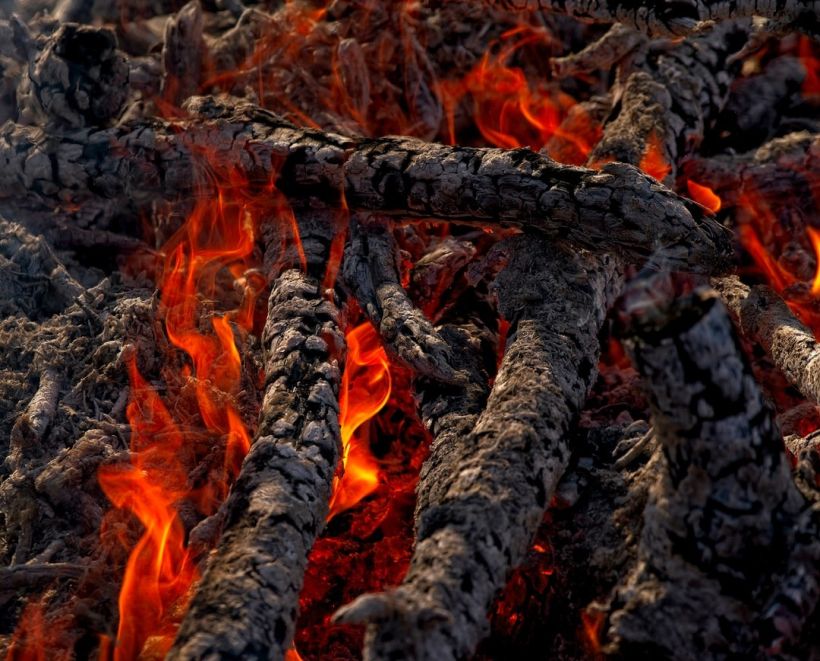
A mine fire can also at times be a Class “B” fire when pockets of methane are encountered. This would cause a flash or fire ball which may burn for several minutes to several hours dependent on the amount of available methane. Fortunately, these Class “B” fires occur underground and would not be noticeable above the ground surface.
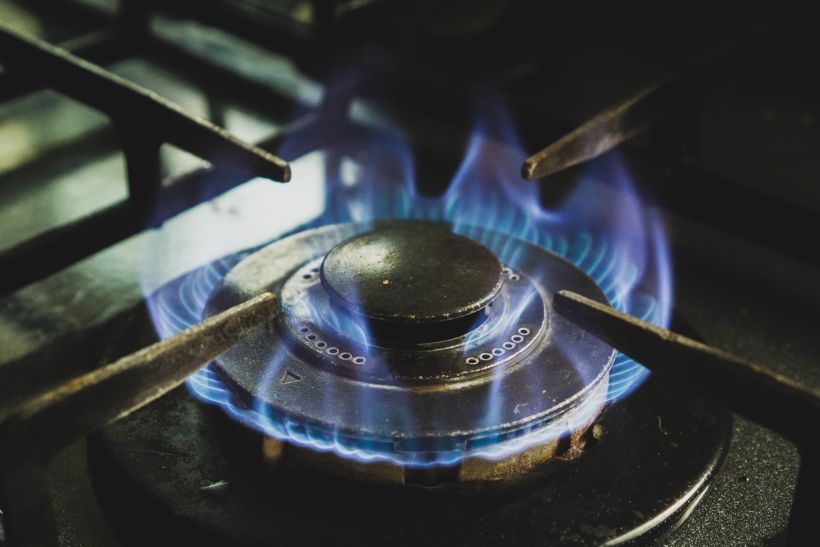
The ignition temperature for coal is dependent on the type of coal and its moisture content. The temperatures listed below are rough average temperatures of the types of coal as compared to wood.
Wood –572° F (300°C) Sustained burn 1472 to 1742°F (800 to 950°C)
Lignite – 525° F (274° C)
Sub-Bituminous – 662° F (350° C)
Bituminous Coal – 700° F (371° C)
Sub-Anthracite – 752° F (400° C)
Anthracite Coal – 1,700° F (927° C)
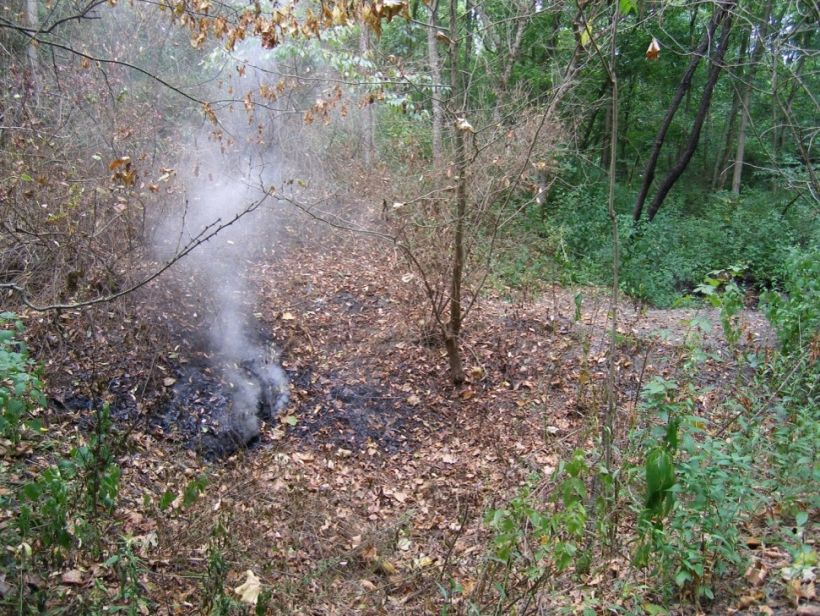
First of all, stay clear of the vent.
If the smoke or vent is near/entering a building or is in danger of causing personal or property damage, call 911.
If you discover a vent where there is not an immediate health or fire risk, contact your states abandoned mine lands office and notify them of your discovery.
When notifying your state via phone or email, please include or have ready the following information:
- Your name and telephone number
- Location of event or closest crossroads
- County and township or municipality
- And a description of the issue
- If able, provide picture(s) of the danger
How are mine fires extinguished?
There are several factors which can dictate how a mine fire is extinguished.
- Size of the area which is affected by the burning coal.
- Depth of the coal seam.
- Location of the fire within the coal seam and mined areas. Important to determine potential pathways the fire may progress.
- Length of time the fire has been burning.
- Local geology.
- Presence of methane.
- A few others
The reality of fighting underground fires is that a combination of methods presented below can be used as well as other firefighting techniques.
Like all fires, the faster the response time the greater the chances of extinguishing it with minimal costs and environmental damages.
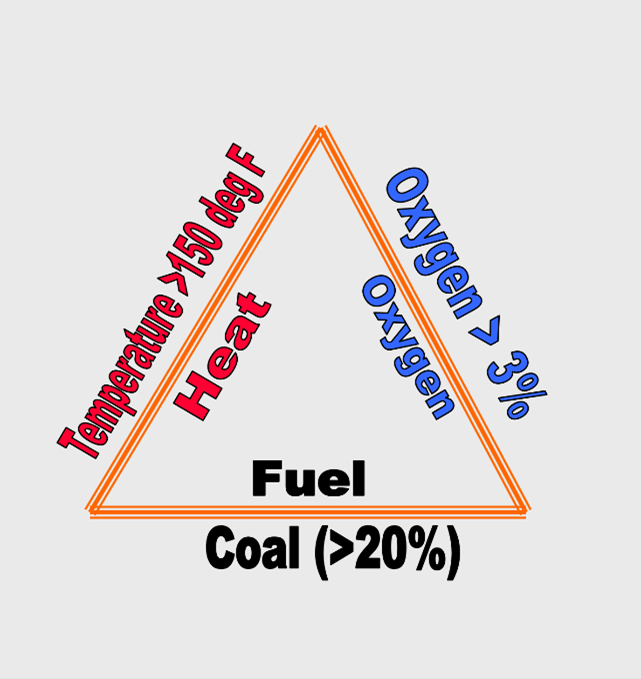
A fire can only be extinguished by removal of one of the legs of the fire triangle, shown below. For coal to burn it must have a temperature of at least 150 degrees Fahrenheit, greater than 3% oxygen (21% oxygen in the air we breathe), and greater than 20% coal particles by volume. Removal of any one of these items will result in the fire extinguishing.
There are three basic types of extinguishment concepts.
- Isolation – This concept attempts to remove or reduce the available fuel supply (coal) to the fire thereby eliminating the fuel portion of the fire triangle. Included within this concept is hazard removal from the fire areas.
- Encapsulation – This concept involves covering the fire indirectly with a medium which will limit or prevent the flow of oxygen from reaching the fire.
- Injection – This involves injecting flowable solutions into the mine voids at or near the fire location to remove the heat or prevent oxygen from reaching the fire.
Fire Isolation Concept
There are several common practices which use the isolation concept to fight mine-fires. They include:
- No Action
- Relocation/Removal
- Trenching
- Impassible Barriers Walls
- Injected Barrier Walls
- Cutoff Walls
In all cases, the objective is to decrease the impacts of the fire on the public/environment or reduce the available fuel source for the fire.
“No Action” Application:
This application does not involve any remedial action. The fire is left alone to burn unabated.
Overall Effectiveness: Not effective. Fire and associated hazards remain and will continue until fuel is exhausted.
Environmental Impact: High potential for environmental and public impacts. Mine fires left to burn unabated have the increased risk of igniting forest fires/grasslands, formation of new subsidence features, vents, and intakes, as well as expulsion of gasses and soot into the atmosphere.
Relative Costs: Since the fire is not being fought, the associated costs are negligible. However, costs associated with the risks of leaving the fire alone can be quite high.
Worker Safety: Not Applicable.
Public Safety: Public safety risks are high due to hazards mentioned above.
Depth of Fire: Not Applicable.
Multiple Burning Seams: Not Applicable.
Available Technology: Not Applicable.
Treatment Time: None.
Structural Geology: Not a concern.
Gasses, Smoke, and Soot: The risk of gasses, smoke and soot is high due to the lack of intervention.
Treatment by-products: None.
Maintenance and Monitoring Costs: None.
Relocation/Removal Application
This application involves the removal of the public from the dangers of the mine fire. Centralia, Columbia County, PA is an example of where this was used. Monies are made available to affected residences, businesses, and utilities for relocation outside of the fire area. After this is accomplished, the fire is monitored and left to burn. As in the case of Centralia, the fire has been burning more than 50 years.
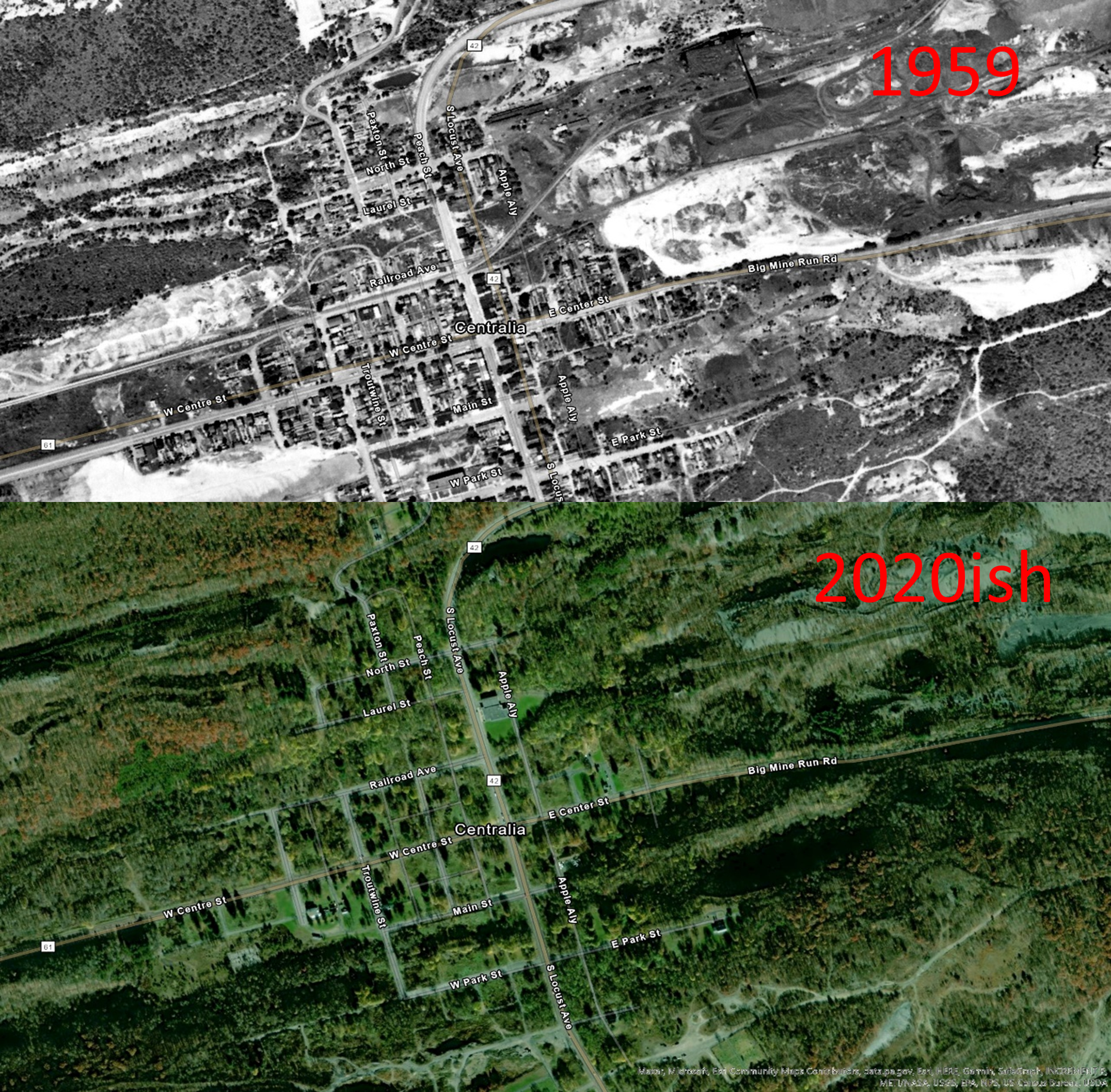
Overall Effectiveness: Effective in removing public interactions with the fire zone. Environmental impacts remain present.
Environmental Impact: High potential for environmental impacts. Mine fires left to burn unabated have the increased risk of igniting forest fires/grasslands, formation of new subsidence features, formation of new vents and intakes, as well as expulsion of gasses and soot into the atmosphere.
Relative Costs: Costs associated with the removal/relocation of private, public, and business structures can be very costly. Furthermore, as the fire continues to burn, the likelihood that new properties will become effected and require relocation.
Worker Safety: There is a minor to moderate risk to workers as properties are purchased and demolished. Mine fire gasses may be present in abandoned structures requiring special monitoring and personal protective equipment (PPE).
Public Safety: Public safety risks are eliminated for parties who relocate. Individuals who choose to remain and spectators/trespassers onto mine fire lands continue to have elevated safety risks.
Depth of Fire: Not Applicable.
Multiple Burning Seams: Not Applicable.
Available Technology: No technologies required.
Treatment Time: None.
Structural Geology: Not a concern.
Gasses, Smoke, and Soot: The risk of gasses, smoke and soot is high due to the lack of intervention.
Treatment by-products: None.
Maintenance and Monitoring Costs: Costs associated with monitoring the fires’ progression are moderate and typically may include temperature observation wells, thermal imaging (aerial), etc.
Trenching Application
Trench firefighting technique involves creating an open trench in the unburnt coal seam ahead of the fire and removing the coal. This method effectively decreases the amount of available fuel for the fire. The fire is then left to burn until it reaches the trench and is extinguished by lack of fuel.
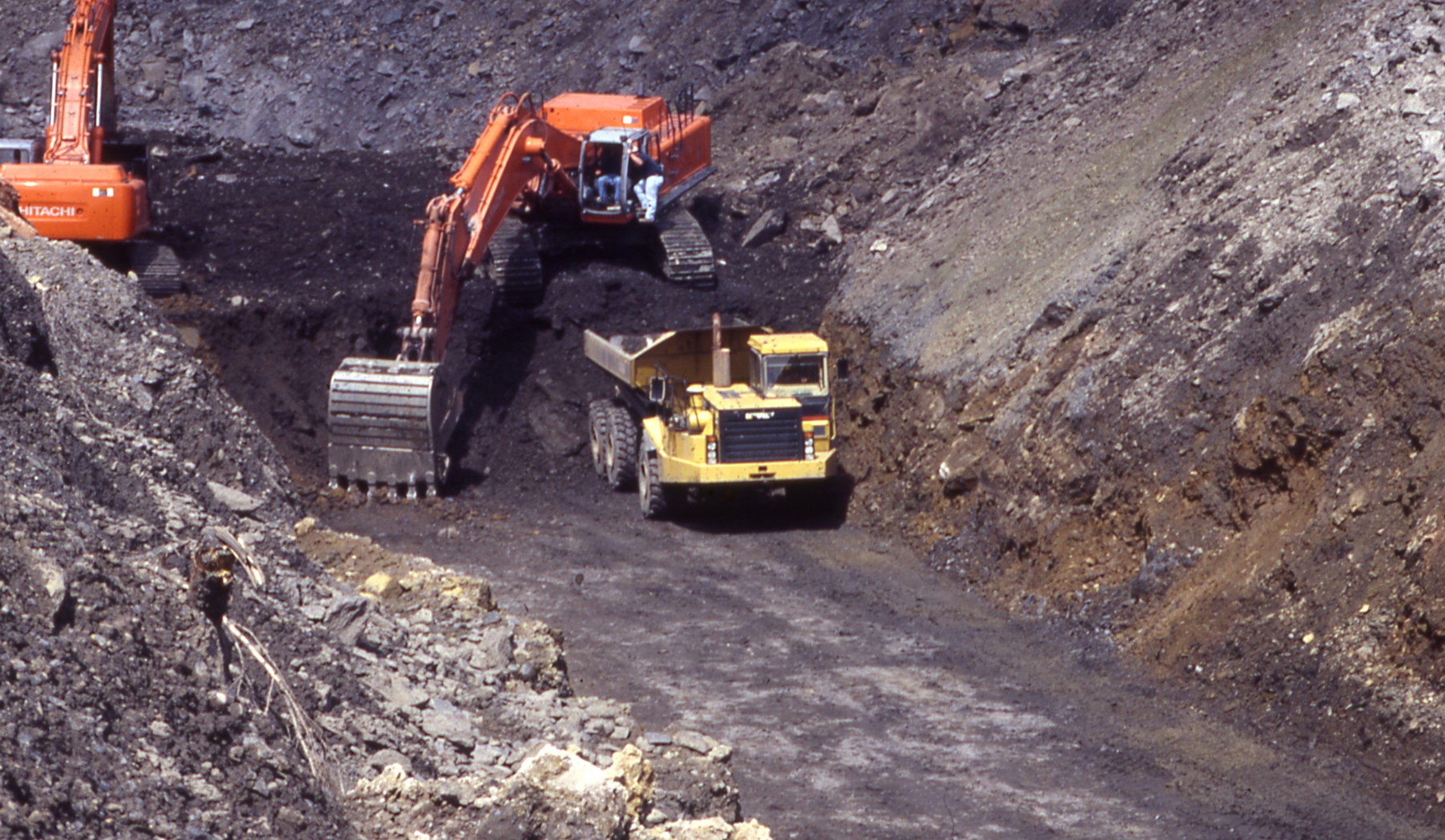
Overall Effectiveness: Very effective if the excavated trench encompasses the fire area. Ineffective in areas where trenching cannot be completed.
Environmental Impact: There is a relatively low environmental impact which mainly encompasses the trench construction zone.
Relative Costs: Excavation/blasting costs can be quite expensive. Due to the expense, this application is more practical for shallow smaller underground mine-fires. This application may also be used in conjunction with other firefighting applications.
Worker Safety: There is a minor risk to workers if the trench is located away from the fire area. If mine-fire gasses are present, personal protective equipment (PPE) will likely be required.
Public Safety: Public safety risks are significantly reduced outside the fire area and trench locations. Site security may be required to keep spectators and trespassers out.
Depth of Fire: Application is generally for small scale mine fires (several acres) with overburdens approximately 70 feet or less.
Multiple Burning Seams: This application is generally not used on multiple seam fires.
Available Technology: Standard excavation technologies.
Treatment Time: Highly dependent upon
Structural Geology: Not a concern.
Gasses, Smoke, and Soot: The risk of gasses, smoke and soot is high due to the lack of intervention.
Treatment by-products: None.
Maintenance and Monitoring Costs: Monitoring costs are minimal to moderate, and the frequency should increase as the fire reaches the trench to ensure the effectiveness of the trench.
Impassable Barriers Application
There are two main applications associated with this technique. In each case, an attempt is made to create a physical non-burnable barrier between the fire and fuel source.
- Injected Barrier Wall
- Cut off walls
Grout or Foam Barrier Walls Application
This application fills mine voids and bedrock fracturing above the coal with grout or foam to create a vertical non-combustible barrier which will slow the fire progression or prevent it from passing.
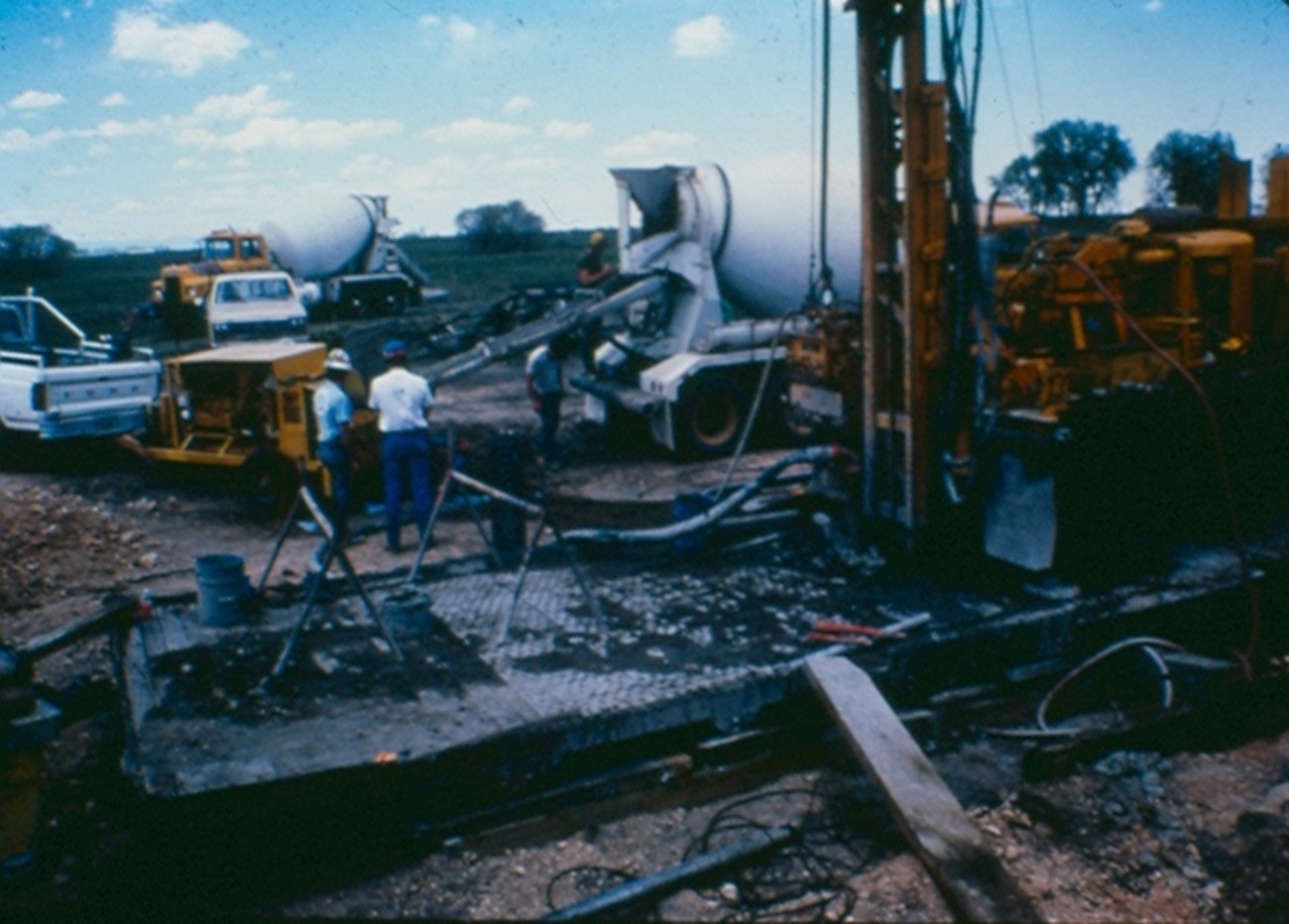
Overall Effectiveness: Very effective if the excavated trench encompasses the fire area. Ineffective in areas where trenching cannot be completed.
Environmental Impact: There is a relatively low environmental impact which mainly encompasses the trench construction zone.
Relative Costs: Excavation/blasting costs can be quite expensive. Due to the expense, this application is more practical for shallow smaller underground mine-fires. This application may also be used in conjunction with other firefighting applications.
Worker Safety: There is a minor risk to workers if the trench is located away from the fire area. If mine-fire gasses are present, personal protective equipment (PPE) will likely be required.
Public Safety: Public safety risks are significantly reduced outside the fire area and trench locations. Site security may be required to keep spectators and trespassers out.
Depth of Fire: Application is generally for small scale mine fires (several acres) with overburdens approximately 70 feet or less.
Multiple Burning Seams: This application is generally not used on multiple seam fires.
Available Technology: Standard excavation technologies.
Treatment Time: Highly dependent upon
Structural Geology: Not a concern.
Gasses, Smoke, and Soot: The risk of gasses, smoke and soot is high due to the lack of intervention.
Treatment by-products: None.
Maintenance and Monitoring Costs: Monitoring costs are minimal to moderate, and the frequency should increase as the fire reaches the trench to ensure the effectiveness of the trench.
Advantages
- Method is less expensive than trenching.
- Fewer safety hazards if barrier is placed outside of the fire zone.
- Can address fires deeper in depth than trenching would allow.
Disadvantages
- The total effectiveness of the barrier cannot be verified from the surface, the likelihood of preventing the fire from passing is low. Grout and foam cannot seal off unmined coal seams, therefore if there is a thin coal seam or parting in the location of the barrier, this would allow fuel for the fire to pass.
- As with trenching, it is necessary to be a distance from the fire to safely allow crews to work without the heat, smoke, and gasses.
- The most effective use of grout or foam barriers is to reduce the immediate advance of the fire giving time to engineers to develop other methods.
Cutoff Wall Application
Cutoff walls are designed to remove all overburden materials to the desired depth of the fire. The trench created is then backfilled with a non-combustible material isolating the fire from further advancement.
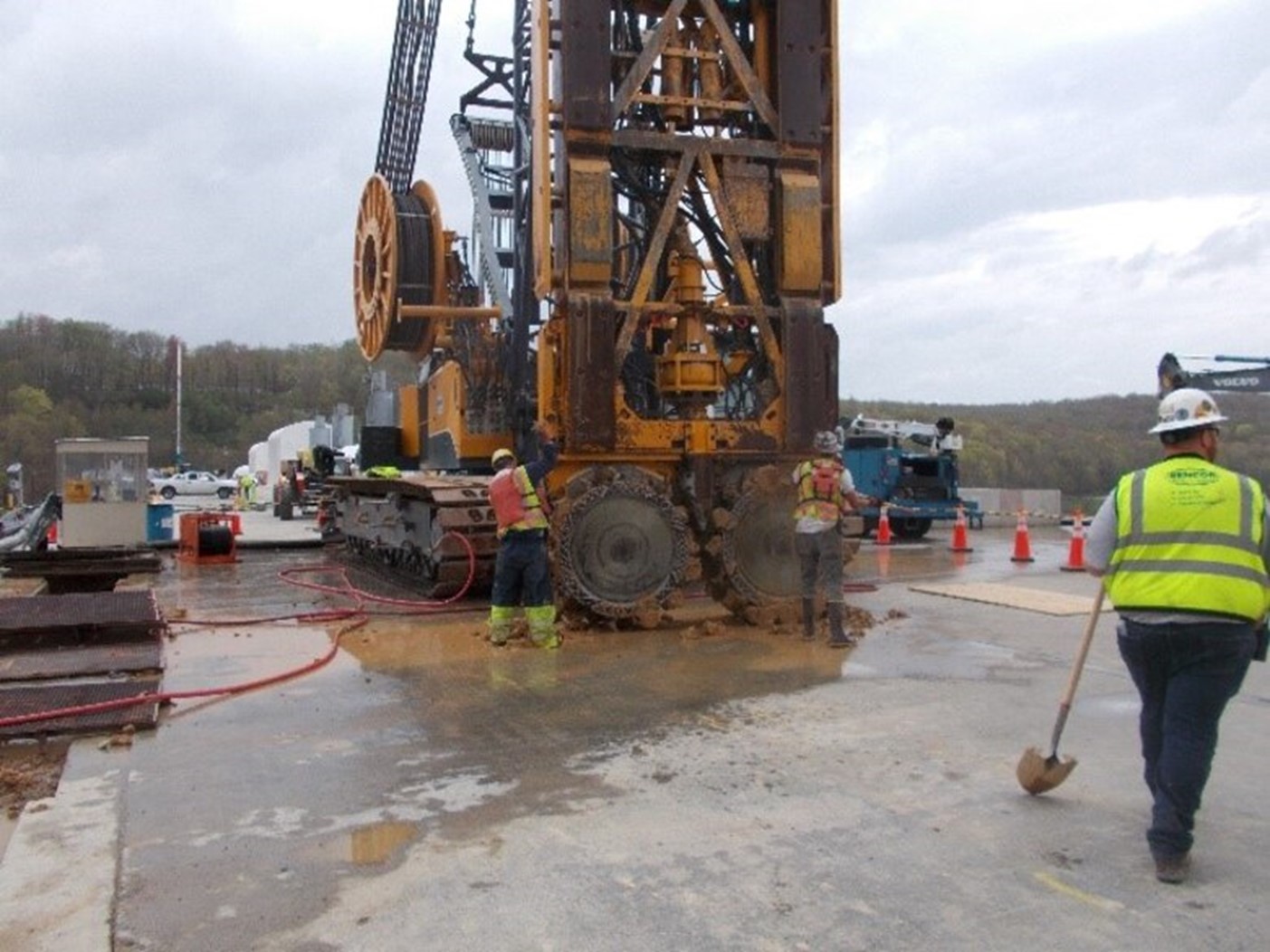
A photo by Greg Hensley, shows a piece of equipment which can dig a trench 3 feet by 10 feet to a predetermined depth.
Overall Effectiveness: Very effective if the excavated trench encompasses the fire area. Ineffective in areas where trenching cannot be completed.
Environmental Impact: There is a relatively low environmental impact which mainly encompasses the trench construction zone.
Relative Costs: Excavation/blasting costs can be quite expensive. Due to the expense, this application is more practical for shallow smaller underground mine-fires. This application may also be used in conjunction with other firefighting applications.
Worker Safety: There is a minor risk to workers if the trench is located away from the fire area. If mine-fire gasses are present, personal protective equipment (PPE) will likely be required.
Public Safety: Public safety risks are significantly reduced outside the fire area and trench locations. Site security may be required to keep spectators and trespassers out.
Depth of Fire: Application is generally for small scale mine fires (several acres) with overburdens approximately 70 feet or less.
Multiple Burning Seams: This application is generally not used on multiple seam fires.
Available Technology: Standard excavation technologies.
Treatment Time: Highly dependent upon
Structural Geology: Not a concern.
Gasses, Smoke, and Soot: The risk of gasses, smoke and soot is high due to the lack of intervention.
Treatment by-products: None.
Maintenance and Monitoring Costs: Monitoring costs are minimal to moderate, and the frequency should increase as the fire reaches the trench to ensure the effectiveness of the trench.
Advantages
- Unlike injectable barrier walls, cutoff walls remove all materials to the coal seam. This ensures that no thin coals are present to allow for the passage of the fire.
- Provides a single barrier in situations where multiple coal seams are burning.
- Creates a trench 3 foot wide by 10 feet long, reducing the amount of material removed by conventional excavating.
- Limited dangers to personnel from mine fire if installed away from the fire location.
- Permanently installed. Wall will not degrade over time and has minimal risk of damage from additional subsidence events.
- Can be useful in large scale mine fires.
Disadvantages
- Limited companies with technology and capabilities.
- High costs in site preparations as well as operations.
- Excessive time frame during installation requiring a fair distance away from fire.
Encapsulation Concept
Like barrier walls, there are two standard applications with a host of different materials to do the job. The concept of fire encapsulation is to reduce or eliminate the oxygen pathways to the fire. This effectively starves the fire for oxygen and decreases the advancement or extinguishes the fire. The two basic applications are:
- Surface Seal
- Mine Entry Seal
Surface Seal Application
This method involves closing and sealing off all oxygen entry pathways and smoke and debris exit pathways horizontally over the ground surface within the fire area. These include such features as exhaust vents, intake vents, and bedrock fractures. This application is typically used for larger mine fires to reduce expended gasses and smoke. The seals are typically composed to local soils, however alternatives such as compressed air, chemical, and water-based foams have also been used.
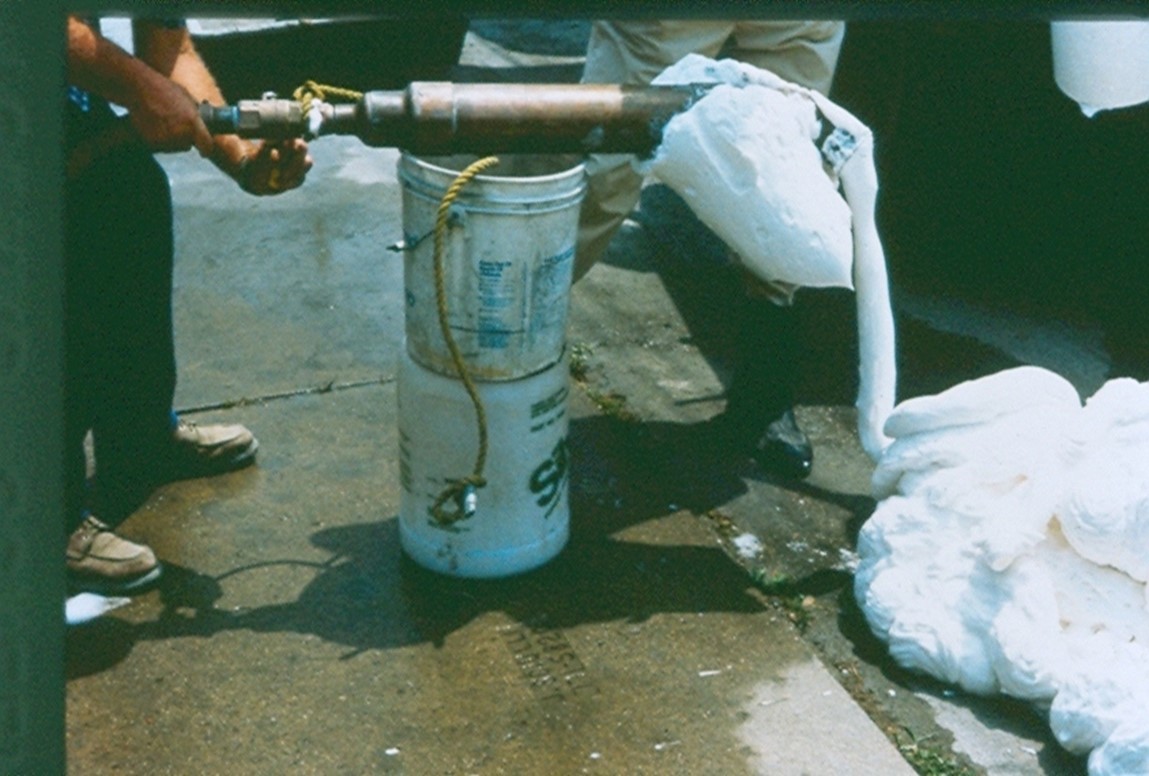
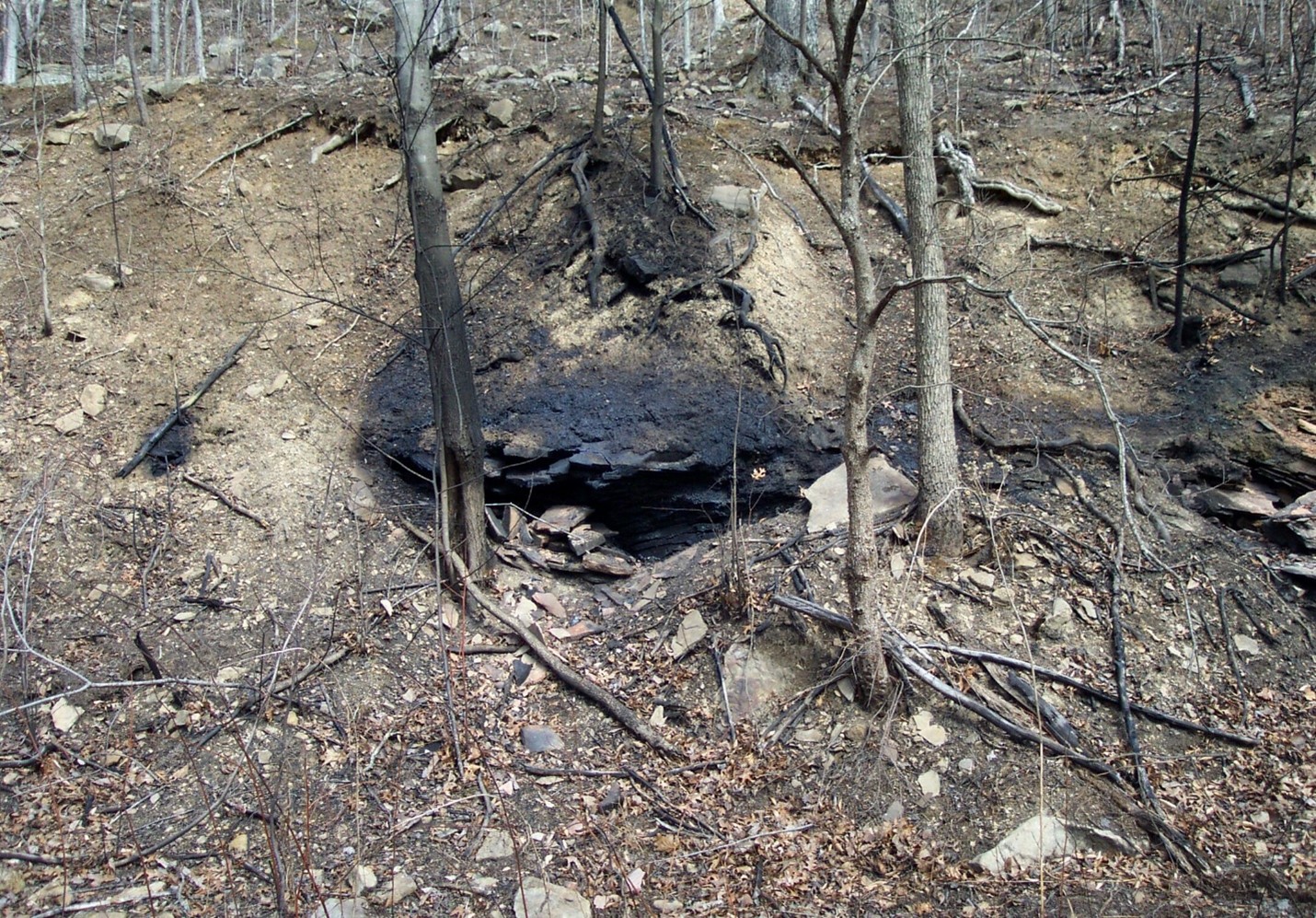 Advantages:
Advantages:
- Less expensive than excavating or cutoff wall installations.
- Useful within large mine fires.
- Treatment locations are easily to identify, especially with thermal imagery.
- Can respond relatively quickly to treat surficial features.
Disadvantages:
- New surficial vents, fractures, and depressions readily form as the fire moves within the seam. This requires frequent inspection and re-sealing as these features form.
- For this method to be effective, both vents and air intake areas need to be sealed.
Mine Entry (Shaft, Drift, Portal Seals) Application
This application addresses the abandoned mine entries. The theory is that if the mine entries are sealed, this will reduce the available oxygen to the fire and restrict the exhaust fumes, smoke and debris which will further choke the fire.
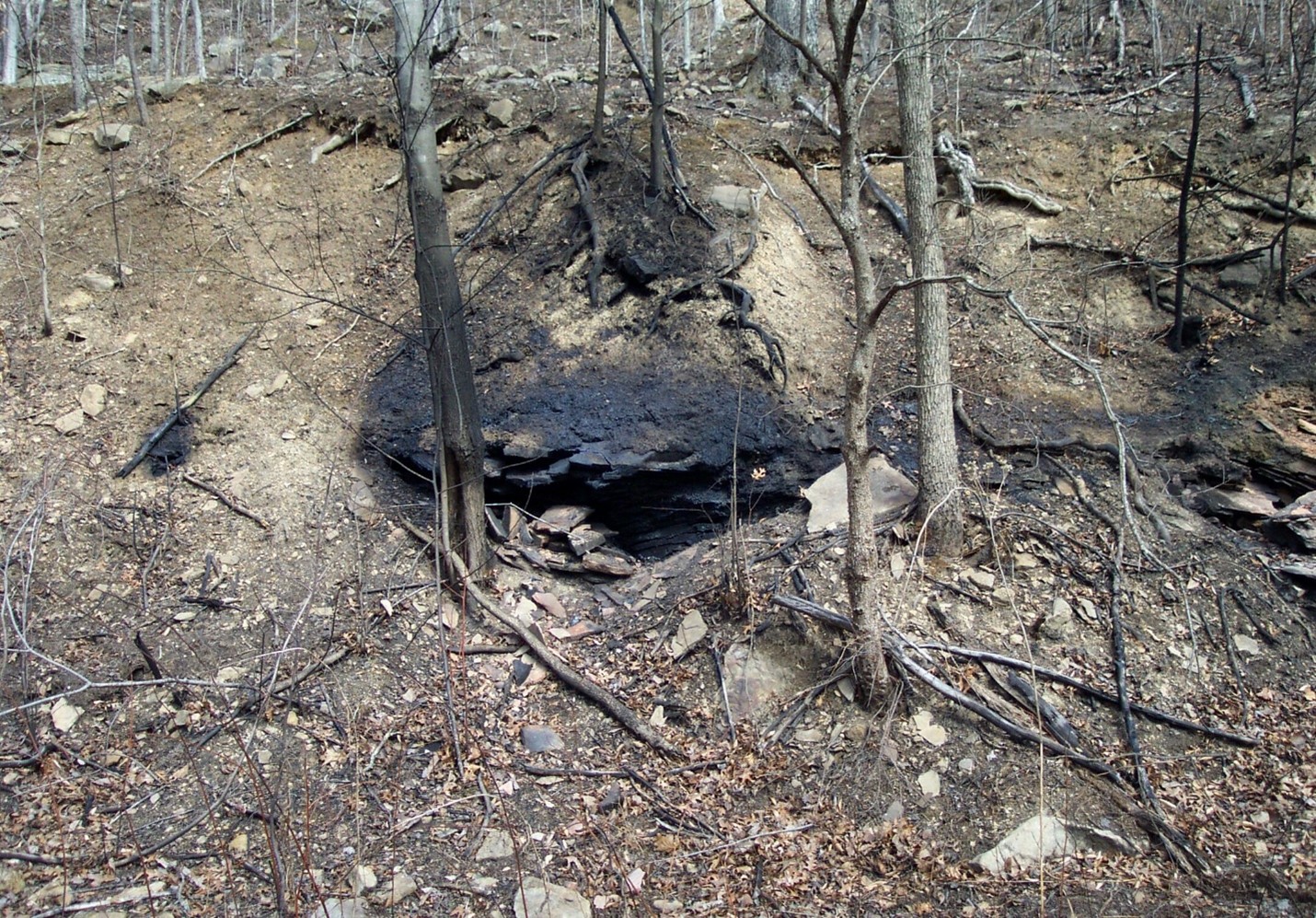
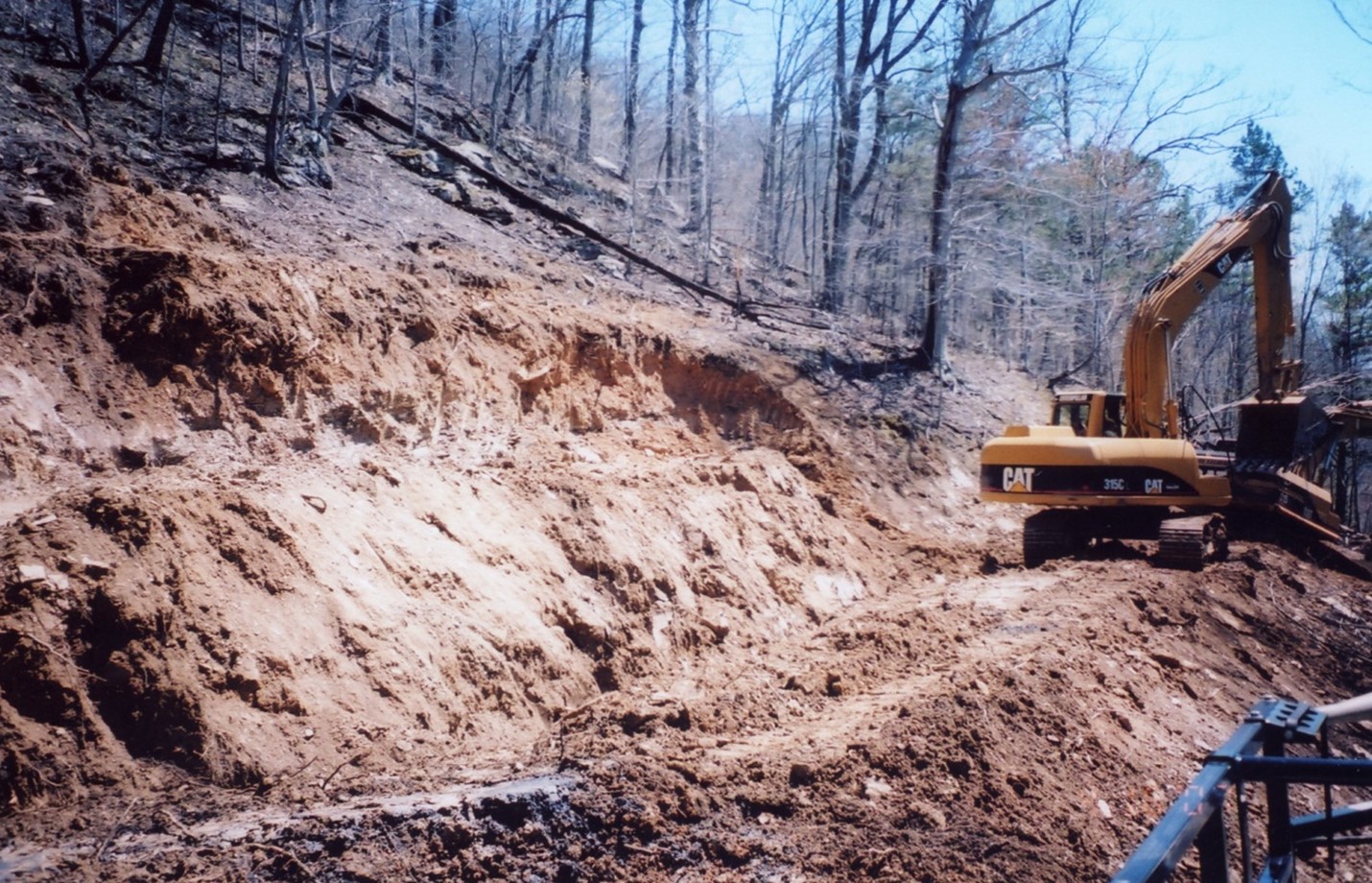
Advantages:
- Relative low cost as compared to barrier walls.
- Entries are easily identified via mine maps, thermal scans, or following outcrops.
- As with surface seals, soil is the typical sealant, but could also be foams as well.
- Worker safety related to fire hazards is minimized assuming the fire is not currently at the opening.
- Limited ground disturbance as compared to other applications.
Disadvantages:
- Likelihood of extinguishing the fire is very low due to unidentified or new oxygen pathways to the fire.
- Constant monitoring and repair are needed as subsidence events reach the ground surface.
Injection Concept
This concept involves fire mitigation at the location of the fire. Because of the fire dangers, this concept does not involve excavations or applications which place personnel in or near the fire. As the title of this concept specifies, the materials used to combat the fire are injected into the area of the fire. Applications associated with this concept include:
Flooding by water injection or injection chemical or water-based foams and/or grout or mud Injections. In some smaller applications, cryogenics could be used to control fires.
Flooding or Injection of Water Application
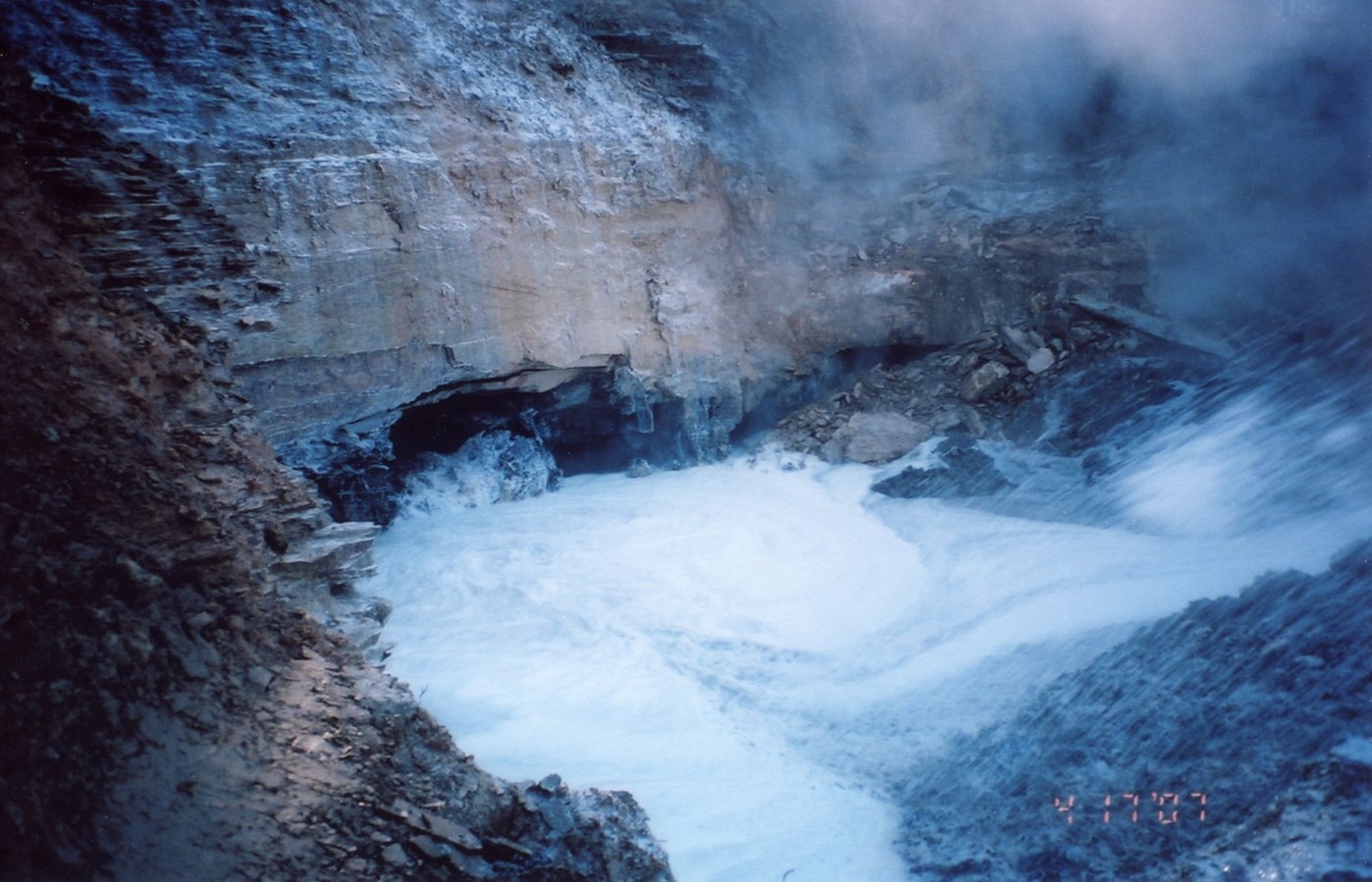 This concept saturates the fire with water effectively removing the heat thus extinguishing the fire. To accomplish this, mine portals are opened or cleaned out to allow the water to flow into the mine. It may also be necessary to create a containment dam allowing the waters to rise in the mine.
This concept saturates the fire with water effectively removing the heat thus extinguishing the fire. To accomplish this, mine portals are opened or cleaned out to allow the water to flow into the mine. It may also be necessary to create a containment dam allowing the waters to rise in the mine.
Advantages:
- This application attacks the fire directly.
- Relatively inexpensive as compared to other applications.
- Minimal surface disturbance.
- Minor fire related dangers associated exhaust fumes, smoke, and debris.
Disadvantages:
- Coal seam dip plays a critical role. If the dip of the seam dips downward from the opening, the water will simply flow through the mine and discharge at another location. This will not allow for the pooling of waters. In this case, all down dip openings should be sealed.
- As the water builds up within the fire area, the high temperatures will cause the water to become steam. This steam will pressurize if an open pathway of venting does not exist. This significantly increases the likelihood of mine blowouts and steam explosions.
- This method also has the potential to significantly increase runoff into local streams carrying mine waste with it.
- Another issue with this type of effort is the movement and pressurization of gasses. This could also force new vents to occur in an explosion style event.
- Furthermore, the steam pressure can build up and reach the surface around the injection well. During injection, a minimum safe distance should be adhered to while injection is occurring and several hours afterward.
Compressed Air, Chemical or Water Based Foam and Grout or Mud Injections Applications
This application attacks the mine fire by saturating it with expanding foams effectively removing the heat and preventing oxygen from reaching the fire. This is accomplished by drilling injection holes into the mine workings near the fire. The expanding foam is pumped through the injection well into the mined coal seam or void spaces next to the fire and spreads out. Over time the foam will expand filling the voids and begins to suffocate it.
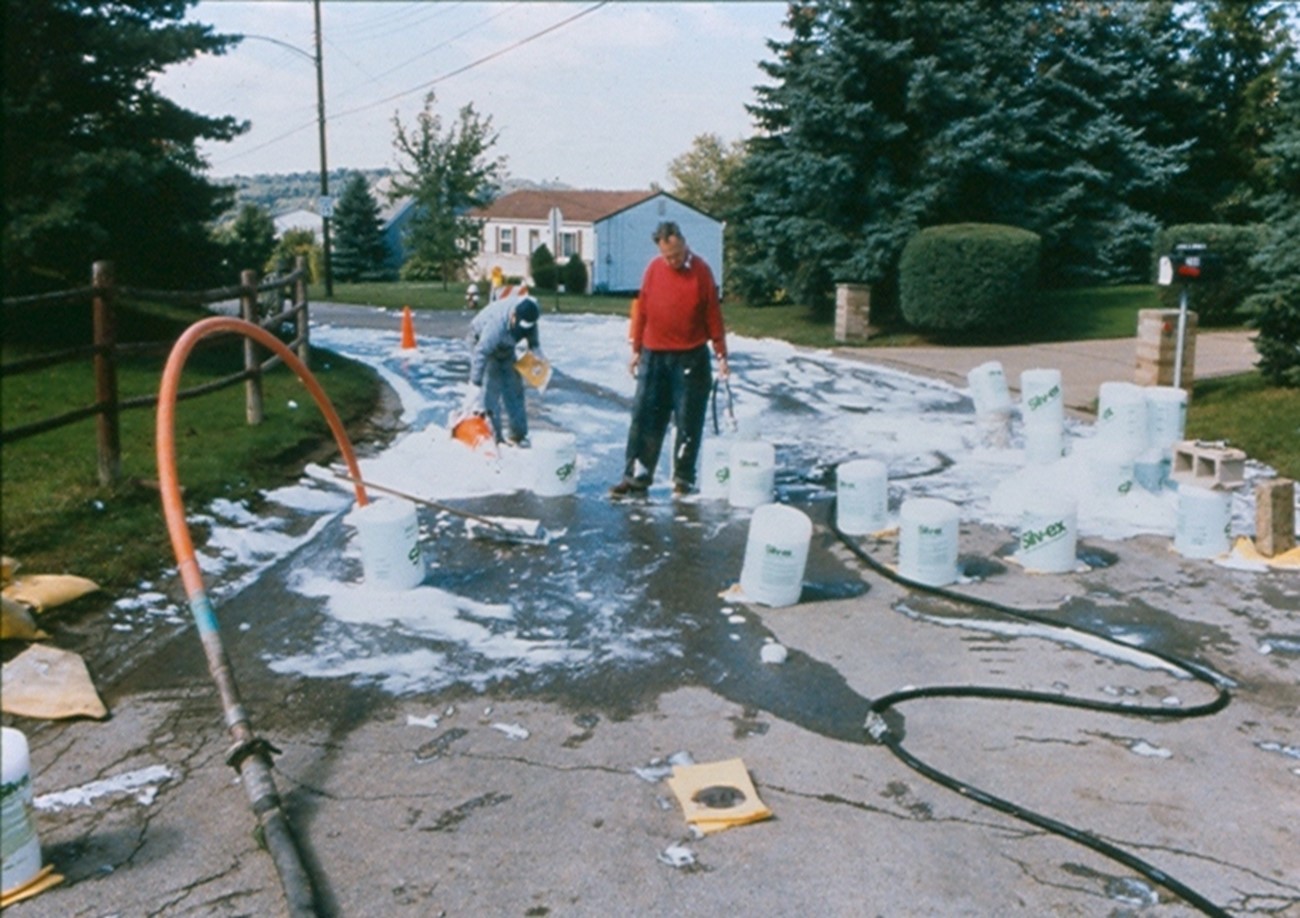
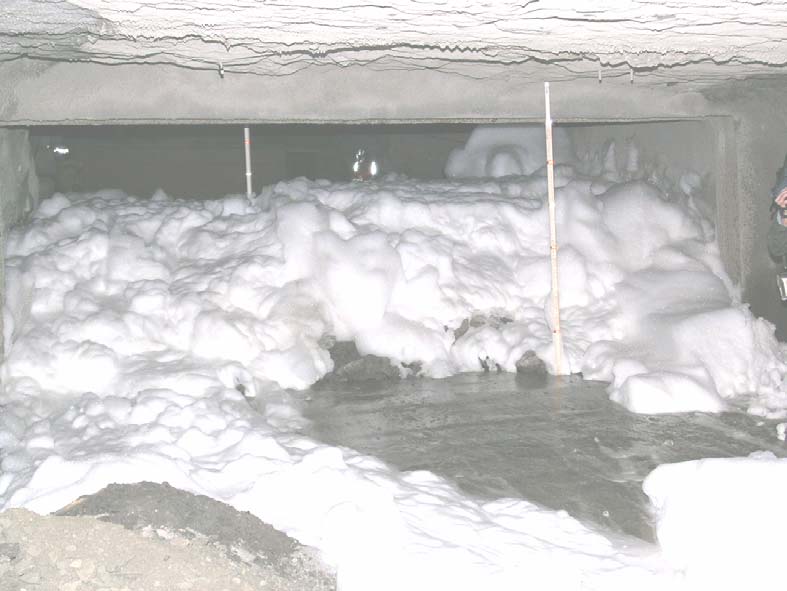
Advantages:
- This method has been effective in extinguishing mine-fires.
- Unlike water this product will not alter to steam, thus reducing dangers from steam pressurization.
- Minimal surface disturbance.
- Minimal dangers related to toxic fumes, smoke, and debris as well as steam (non-water-based foams).
- Useful in larger mine fires in flat lying geologic areas.
Disadvantages:
- Expensive (foam) and difficult to determine if adequate coverage has been achieved.
- Though reduced in likelihood, it is still possible to have steam explosions from water-based foams.
- Drilling of injection points can be dangerous due to steam buildup from the drilling water. Drill steel will also be very hot creating the possibility of significant burns to operators.
Cryogenics Application
The cryogenics application injects a combination of liquid carbon dioxide and nitrogen into the fire area. The concept is that the super cold gasses will remove the heat from the fire effectively extinguishing it.
Advantages:
- Useful in small scale fires which are within a closed or partially closed environment.
- Rapidly extinguishes fire.
Disadvantages:
- Cost and quantity of cooling agent on larger fires.
- Dangers to personnel related to extreme cold.
- Dangers to drillers handling steel super-heated from the mine fire.
- Risk of large quantities of heated carbon dioxide entering adjacent structures creating a potential asphyxiant hazard.
- Risk of large quantities of heated carbon dioxide exhausting from the fire at and around the injection site which would also create a potential asphyxiant hazard.
Burning Refuse Piles
This type of mine fire occurs on coal waste piles. The fire catches on the remaining coal within the pile and behaves like underground fires. That is where the similarities end. The fire fighting applications are all similar in the manor that the mine waste pile is excavated and cooled. The method and materials used varies based on site characteristics.
Due to the proximity of the personnel and equipment to the fire, extreme safety measures need to be adhered to.
Excavations (dry versus wet)
The dry application involves the waste pile to be excavated and spread out in shallow lifts to allow for air cooling. In most cases other material is added to the heated materials to help cool it.
In the wet application, excavated material is doused with water or foam to begin the cooling process. After the addition of the water, the rest of the treatment is the same.
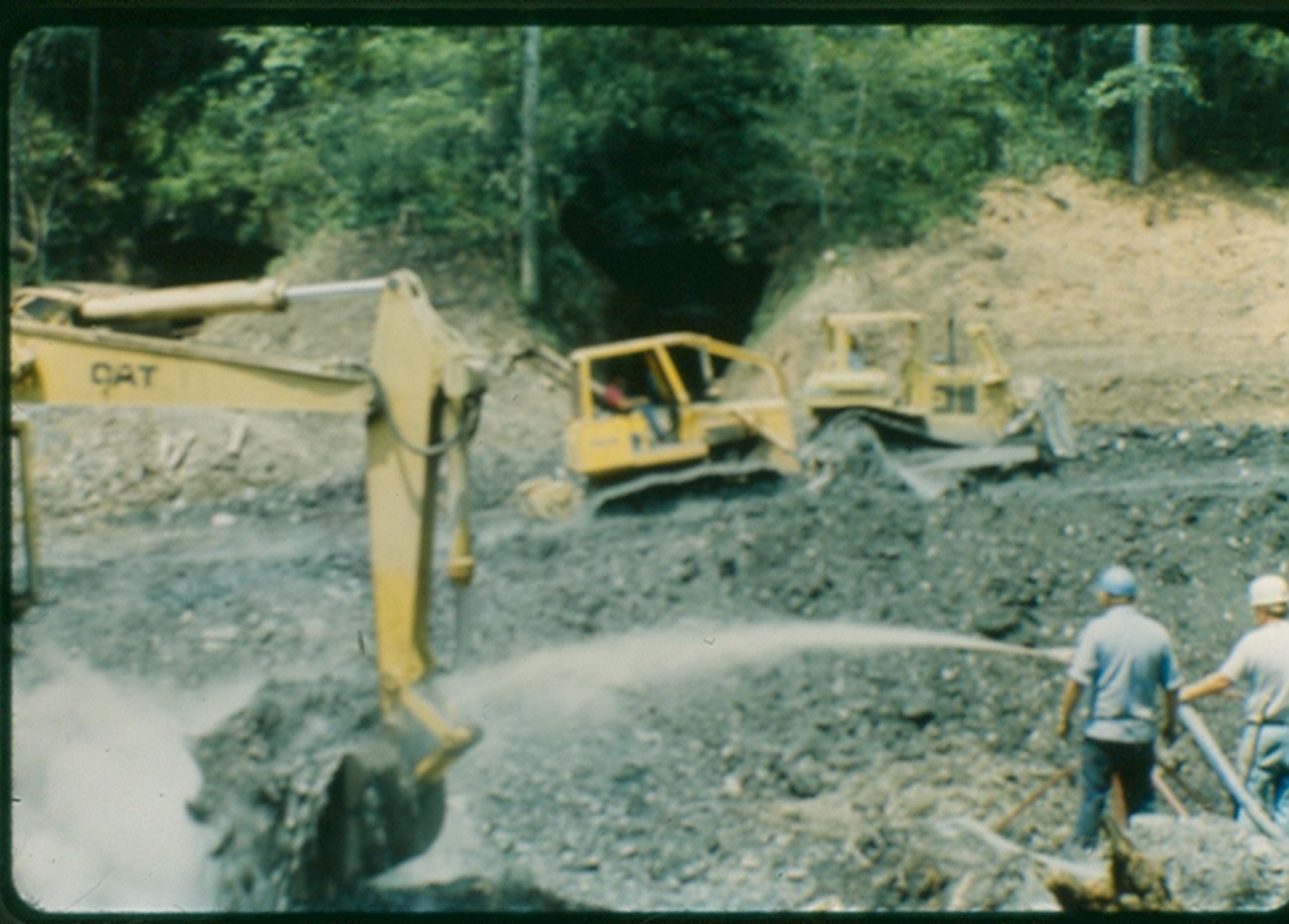
Surface Seal Application
Like the surface seal application for underground mine fires, this application covers the waste pile with non-combustible material (usually soil) to prevent the flow of oxygen effectively suffocating the fire.
Grouting or Injecting Foam Application
This application calls for grout or foam to be injected into the waste pile to saturate voids with non-combustible materials. This saturation is two-fold, removes the oxygen from the fire, and prevents it from moving to adjacent waste.
